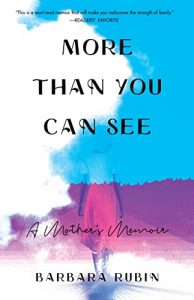My Writing Process By Barbara Rubin, author
My Writing Process
By Barbara Rubin, author
More Than You Can See
 “Write a book,” my friend told me. Impossible! I wasn’t a writer, or was I? But the seed was planted, and my mind began compiling ideas and ways to tell the story. Why was I thinking about doing it? I never wanted to revisit the many memories I would need to conjure up to fully cover the story.
“Write a book,” my friend told me. Impossible! I wasn’t a writer, or was I? But the seed was planted, and my mind began compiling ideas and ways to tell the story. Why was I thinking about doing it? I never wanted to revisit the many memories I would need to conjure up to fully cover the story.
It had been twenty-seven years since my teenage daughter, Jennifer, had suffered a traumatic brain injury in a car accident leaving her with a profound disability; she had no way to communicate. But without words, she connected with people and not only touched their hearts but had a positive influence on their lives. There was beauty in the story, but I knew there were also painful parts that would darken my spirit and leave me feeling despondent if I took on the project.
Thoughts about how to tell the story persisted. I had to get them out of my head, write them down, start a document file, and see where the process would take me. My friend’s voice echoed in my mind encouraging me to share my story, give others the opportunity to learn about traumatic brain injury, and offer readers the chance to understand the challenges of recovery and the healing that comes with time, love, and kindness.
An outline kept buzzing around in my mind. It felt like a freight train whose long series of boxcars line the track before it slowly begins to leave its first station; the destination stretching far beyond the horizon with many required stops along the way. At each new station, precious additional cargo would be carefully loaded onto the train. My mind was collecting the salient points needed for my story to be told. I was starting to move forward with my book as the direction was carefully getting mapped out. I realized what at first seemed impossible was happening. I had a story to tell; there was no turning back.
I started writing brief summaries of key sections, letting the words flow without regard to sentence structure, redundancy, accuracy of timeline, or any other complications that would interfere with my creative energy. I was getting the words down; corrections would come later.
Each time I began to write, I let my mood dictate which section I worked on. My focus was on the substance of what I was writing, not the overall continuity of the manuscript. I was like that train chugging along the track, dealing with the immediate hurdles and obstacles, not worried about the distant stations, or the terminus of the journey. More Than You Can See was moving forward; it was working toward its publishing destination.
With several segments completed, I began to interview the main characters in my story to collect interesting tidbits of information to include in the book. What I got from those conversations was more profound than I could have imagined. Jenn’s caregivers and their families provided me with an abundance of reflections on their interactions with her that I had been unaware of. With this new input, I knew the story was deeper and more meaningful than I had originally thought.
The drive to share this story and see it through to the final station motivated me, providing fuel to carry me forward on the long track to publication.
As the chapters came together and the story was completed, it was time to give the material more polish and clean up the text from its original form. Paragraphs were rearranged, redundancies deleted, and the first edit was completed. I was optimistic about how things were going. Early readers gave positive reviews, so I felt I was on the right track in my writing adventure. But then I stopped! I put the manuscript aside, letting it sit idle for months going nowhere. Why did I abandon my project after all the effort put into it? I didn’t know or understand the steps needed to get me going to the next station.
It took a friend suggesting I contact the National Memoir Writers Association (NMWA) and attend the San Francisco Writers’ Conference to get my train off the siding and back on track. This friend was like a second engine brought in to get my train moving again. I hired an editor from NMWA, and I was once again on a roll. There was a steep uphill trek to face before my writing was up to speed, but I was open to the help and ready to move forward.
Edit, revise, edit, do it again. Who knew a book would need so many revisions? I didn’t. I was a newbie and didn’t know this was what it was like to be an author, but I wanted to learn. I was open to suggestions and criticism. It was my job to listen, rewrite, and be receptive to all the corrections that came over many months from my editor. I needed this professional to guide me through the process of giving my material structure and building on the emotional aspects that would give my readers a better viewpoint of the story I was telling.
Attending the San Francisco Writer’s Conference opened my eyes to the publishing industry.
Up to that point, I had been driving my train with blinders on. Understanding the challenges and mechanics of describing scenes in a way that allows a reader to follow an author’s narrative and become engaged in the story, was one example of what I learned from the lectures at the conference. Valuable information on how to develop my storyline in a more compelling way was clearly presented, and I was all ears. Until I attended that conference, I didn’t recognize the methods authors used to draw a reader into a story and keep them turning to the next page.
It was also important for me to learn all the steps leading up to getting published, and what it takes to have a book sitting on a retail shelf. Not only did the conference point me in the right direction for my book, but it gave me a new-found appreciation for other authors’ work and the hurdles they faced to bring their books to fruition. I learned to have great respect for all the authors whose books I had read over my lifetime.
With edits completed, my book was off to the printer. The journey to reach that point was like the miles of track that had once loomed ahead for the freight train, but now stretched far behind as it pulled into the final station. All the stops along the way are in the past; More Than You Can See reached its last station right on schedule−October 4, 2022. It was a long time coming, but I am excited as all the treasures held within its pages are now available for the public to enjoy.
—
Barbara Rubin writes this story of joy and sorrow mixed with humor and rage as both mother and advocate for her daughter Jenn. In this role, she witnessed firsthand the battles that come when a person is the most vulnerable, but she also saw the gift of human kindness and the difference it can make in another person’s life. She hopes that her journey, lived through her daughter’s injury, will help others understand the lessons that can be learned from tolerance and will give hope to families whose paths have also been darkened by tragedy. This is her first book. Barbara resides in Washington Crossing, PA
Find out more about her on her website https://barbararubinauthor.com/
MORE THAN YOU CAN SEE
 At seventeen, Barbara’s daughter Jennifer is in a horrific car accident and sustains a traumatic brain injury that sends her into a two-week coma. Once she awakens, a unique disability presents itself: Jenn lacks any traditional method of communication. Unable to speak or function on her own, Jenn must relearn basic life skills in a rehabilitation facility while Barbara and her family struggle to piece together their lives, now forever changed.
At seventeen, Barbara’s daughter Jennifer is in a horrific car accident and sustains a traumatic brain injury that sends her into a two-week coma. Once she awakens, a unique disability presents itself: Jenn lacks any traditional method of communication. Unable to speak or function on her own, Jenn must relearn basic life skills in a rehabilitation facility while Barbara and her family struggle to piece together their lives, now forever changed.
When it becomes clear that Barbara and her husband cannot care for Jenn on their own, they move her to a group home. Over time, three creative, lighthearted women become Jenn’s caregivers, and with their support Jenn reenters the community and experiences travel and adventure, all while capturing the hearts of those around her with her engaging and quirky personality.
Despite her disability, Jenn connects with everyone in her life. And Barbara ultimately realizes that Jenn’s lack of language doesn’t stop her from having a voice. A touching memoir that strikes a delicate balance between sorrow and joy, heartbreak and triumph, More Than You Can See is Barbara’s story of moving beyond tragedy and discovering profound and fulfilling life lessons waiting for her on the other side.
BUY HERE
Category: On Writing

























